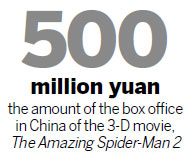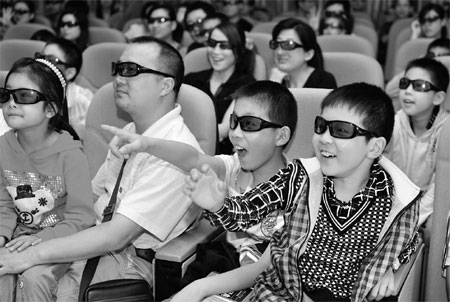Theater screens filmed over with 3-D
Updated: 2014-06-01 07:27
By Huang Ying(China Daily)
|
|||||||||
Three-dimensional films are the flavor of the times, but not all is well with domestic productions because Chinese viewers still prefer spending on Hollywood flicks, writes Huang Ying
Zhang Bing's most satisfying and exciting film-viewing experience this year has been the Hollywood blockbuster The Amazing Spider-Man 2, which hit the screens on May 4, right after the three-day Labor Day holiday. More surprising is its ticket price - just 20 yuan ($3.20). "It's that cheap because the theater (where it was released) opened recently," says Zhang who works as a clerk in Hangzhou, Zhejiang province. Zhang is among those Chinese moviegoers who make it a point to go to the cinema whenever a film they consider intriguing is released.
"Generally speaking, I will watch a movie in a theater if I think it will be interesting," Zhang says. "When few quality movies are released, I stay away from cinemas for as long as one to two months," she adds.
Screened in 3-D and Imax 3-D versions, The Amazing Spider-Man 2 had grossed more than 500 million yuan at the box office in China - the world's second-largest movie market - by the end of May 18, according to EntGroup Consulting, a Beijing-based entertainment industry consultancy. This shows the Chinese audience's increasing passion for 3-D movies, especially imported 3-D and Imax productions.
In the first three months of this year, China's box office revenue reached 6.7 billion yuan, exceeding the 2009 total, with more than 50 percent of that amount coming from 3-D movies. "Most of the box office revenue of 3-D movies are generated by imported productions," says Peng Kan, research and development director of Legend media, a Beijing consultancy company.
Explosive growth
The explosive growth in box office returns in China has a lot to do with the rapid expansion of theaters and the rising number of screens. Speaking at a 3-D industry forum in April, Hou Tao, vice-president of EntGroup Consulting, said the number of 3-D screens in China has increased from 700 in 2009 to the 19,000 today, with the percentage of 3-D screens among digital screens increasing from 15 percent to 82 percent.
By the end of March, the total number of screens in China had crossed 20,000, with more than 95 percent of them being digital.
"But the market for 3-D screens is still far from saturated," says Shen Hongxiang, chief operating officer of Soulpower Culture Media Co, a leading stereoscopic 3-D film and TV production company.
The popularity of 3-D movies has prompted many domestic film companies to pursue the industry's trend, but the audience response they have got differs tremendously. "I can hardly remember a domestic film released in 3-D format," Zhang says when asked to name a domestic 3-D film.
A few minutes later, she names The Monkey King, a domestic production released on Jan 31, which depicts the story of the Monkey King in heaven before he joins his master on a journey to the west. It was the highest-grossing film in the first quarter of the year in China, raising 1.05 billion yuan at the box office.
But Zhang regrets spending 60 yuan to watch it. "The whole plot stinks, and the visual effects are just like an animated feature. I didn't like it at all," she says.
Five of the all-time top 10 box office hits in China are domestic productions, with four of them being in 3-D format. The other five, all Hollywood movies, were either in 3-D or Imax format.
Chinese filmgoers prefer to spend on Hollywood 3-D productions rather than domestic flicks because of the latter's poor quality. In fact, some Chinese films are offered in the 3-D format just to make more money, because ticket prices for 3-D movies are a lot higher than 2-D movies, Shen says.
"A ticket for a 3-D film costs at least one-third more than that of a 2-D film," Peng says.
Conversion to 3-D
Most of the filmmakers prefer to convert 2-D films to 3-D products at the postproduction stage, because it is cheaper than 3-D on-set shooting. "Domestic films that spend more than 100 million yuan in production will go for 3-D on-set filming, while those whose production budget is 50-80 million yuan will opt for 2-D-to-3-D conversion," Shen says.
"The cost for 2-D-to-3-D conversion has declined in the country, and some could be done for only 3 million yuan. But for our company, the threshold is 5 million yuan for this service," Shen says. "A part of even the movies that opt for on-site 3-D shooting requires 2-D-to-3-D conversion during postproduction," he says.
The screening process in theaters, too, affects moviegoers' viewing experience. Many of the negative comments on 3-D productions released in the country have something to do with the theaters, Peng says.
"Some theaters lower the brightness of the projection light, an important part of the screening equipment, to prolong its service life and thus darken the picture, leading to complaints from the audience."

Another reason why domestic filmmakers opt for 3-D productions is the financial reward from the government. If a domestic movie in 3-D format or tailored for giant screenings grosses between 50 million yuan and 100 million yuan at the box office, the government will reward its makers with a subsidy of 1 million yuan, according to a policy issued by the State Administration of Press, Publication, Radio, Film and Television, China's film industry watchdog. The reward is 2 million yuan for films grossing between 100 million yuan and 300 million yuan, and 5 million yuan for those making between 300 million yuan and 500 million yuan.
Foreign slowdown
In December, the government raised the subsidy, granting additional financial support to movie copyright owners if their enhanced-format movies in all the three box office categories made an extra 25 million yuan in ticket sales. But for films earning more than 500 million yuan at the box office, the subsidy remains at a standard 10 million yuan, regardless of further increases in their ticket sales.
Unlike the burgeoning market of 3-D movies in China, other movie markets in the world have witnessed a slowdown in the growth of 3-D screens. Despite the continued increase in the number of 3-D screens around the world, the growth rate of global 3-D screens plunged from 27 percent in 2012 to 17 percent in 2013, failing to catch up with the overall growth rate of digital screens, according to statistics from the Motion Picture Association of America.
In addition, the share of 3-D screens among digital screens fell from 51 percent in 2012 to 47 percent in 2013 globally, according to the MPAA statistics. Globally, 3-D movies generated $7.4 billion in box office returns in 2013, up 2 percent year-on-year, but their proportion in the total ticket sales dropped from 21 percent in 2012 to 20.6 percent, to Peng says.
This shows that "Chinese viewers are more accepting of movies that offer them a spectacular viewing experience, like 3-D or Imax, compared with their overseas counterparts", says Peng.
Contact the writer at huangying@chinadaily.com.cn
|
Children watch a popular science film with their parents at a youth center in Yichang, Hubei province. Zhang Guorong / for China Daily |
|
A boy poses in front of the movie poster of The Amazing Spider-Man 2 at a cinema in Yichang, Hubei province. Liu Junfeng / for China Daily |
(China Daily 06/01/2014 page8)

